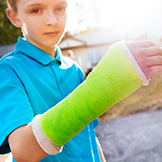
You can’t wrap your children in bubble wrap. It’s important to allow them to run free and play when you can and yes, they probably will get hurt from time to time. But it’s important to know that it doesn’t take much for a child to break a bone. When this happens, seeking treatment from a specialist is key. That’s where pediatric orthopedic specialists come in. Beyond broken bones, pediatric orthopedists also treat limb and spine deformities such as scoliosis, gait abnormalities, and bone or joint infections and tumors. Pediatric orthopedists are experts who are specially licensed to care for the skeletal framework of children. They also know how to relate to younger patients with care and empathy and a communication style that resonates with kids.
The big difference between the bones of children and adults is active growth. “You can think of bone as a bank account, where (with your help) your kids make ‘deposits’ and ‘withdrawals’ of bone tissue. During childhood and adolescence, much more bone is deposited than withdrawn as the skeleton grows in both size and density,” explains the National Institutes of Health.
What is a Growth Plate?
When it comes to injuries, children face a different set of risks and consequences than adults. Children have growth plates, which are areas of cartilage found at the ends of their bones. As a child ages, growth plates eventually harden or ossify, becoming what is commonly thought of as solid bone. Growth plates are not as strong as ossified bone and as a result, they are susceptible to fracture. According to the Academy of Orthopaedic Surgeons, “If not treated properly, it [a fractured growth plate] could result in a limb that is crooked or unequal in length when compared to its opposite limb.”
Getting it Right
Pediatric orthopedists work daily with growth plates as well as other health challenges unique to kids. Generalists without specialized experience can sometimes miss the intricacies, nuances and unique characteristics of the musculoskeletal structure of children. According to a recent study conducted by the Orthopaedic Institute for Children at UCLA, 275 children were treated for fractures at community hospital emergency rooms or urgent care centers. The findings revealed high rates of concerning outcomes when pediatric orthopedic specialists were not involved, such as:
- More than 90% of splints were placed improperly.
- In 59% of cases, the joint wasn’t set into place correctly.
- In 52% of cases, the splint was not the correct length.
- In 40% of cases, there were soft-tissue and skin complications from the treatment.
Creating a Special Place for Kids
Pediatric orthopedists can’t do their jobs properly unless they work in a facility designed for the care of kids. And they certainly don’t work alone. A pediatric team consists of doctors, nurses, and physical and occupational therapists. When you’re working with kids, especially children who may be in pain—feeling scared, anxious or confused—compassion is a required professional trait.
Dr. John Schneider at MOSH are not only specialists in pediatric orthopedics, but they rank on the Top Doctors list published by Milwaukee Magazine. The reason is that they view pediatric medicine through the eyes of children and their parents. They seek alternative solutions to surgery whenever possible, they use psychology, technology and humor to make a patient’s experience a positive one, no matter their age. And they are surrounded by a team of caring orthopedic specialists who love kids and work in a kid-friendly, state-of-the-art facility. It all adds up to better outcomes for children. If you’d like to consult with Dr. Schneider, schedule an appointment for your child today.